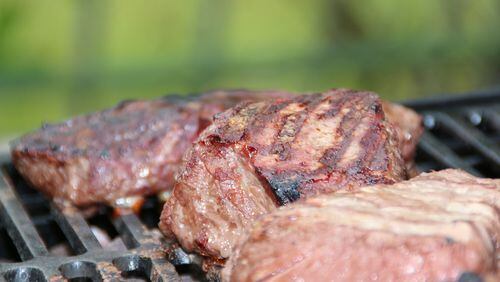Good news for meat eaters, Paleo lovers, and Whole30ers: It's possible to keep up with your animal-protein habits without spending last week's paycheck at the grocery store. Whether you eat meat every day, because that's what makes you feel your best, or you like dabbling once or twice per week to get in your protein fix, buying meat can get pricey. But it doesn't have to... unless you're one of those filet-mignon-only kinda folks. The world of meat is so much more than that tender cut of beef, and we'll open your eyes to what's out there. Save a dollar (or 10) by following these tips.
1. Buy the whole animal.
OK, we aren't talking about bringing an entire pig home with you and having a roast (although, if you have the setup, we're jealous, and you should do it). We're mostly referring to chicken. It seems so easy to just buy the breasts, but when you're talking about price, it's best to buy the whole dang bird. This really goes for other types of animals too, because any labor incurred at the butcher counter gets added to the price tag. Boneless pork chops and rib eyes will be pricier than bone-in, and let's not even talk about prechopped stir-fry meat. Plus, buying the whole animal means you'll be able to use scraps for other nutritious creations (see No. 4).
[7 protein-packed foods cheaper than beef]
2. Think outside of filet mignons.
One way to make meat eating more sustainable for the environment (meaning that you can utilize more of what the animal has to offer) is to diversify your meat selections and start integrating lesser-known cuts into your cooking routine. These less-common cuts are usually the more affordable ones, so it’s a double win. Ask your butcher to recommend some cheaper options from the case (since they’re used to going home with the stuff no one else wants... mainly because the customers don't know what it is). A few reccos you might hear for steak are:
- Instead of rib eye: Denver, underblade, or chuck eye
- Instead of beef tenderloin: Teres Major (known as faux filet)
- Thinly sliced sirloin meat or short ribs make for a flavorful stir-fry
When it comes to affordable roasts, they can be sourced from many parts of the animal. Fattier, tougher cuts like these usually benefit from a low and slow braise, which makes them perfect for wintertime stews and roasts:
- For pork: Try the collar, shoulder, or butt
- For lamb: Go for a whole leg or sirloin roast
3. Embrace offal. (We swear it's not awful.)
Now that we're acquainted with less popular cuts, it's time to get comfortable with the "nasty bits" that really aren't so nasty after all. Offal refers to an animal's organ meats. Common varieties are liver, brains, intestine (tripe), thymus gland or pancreas (sweetbreads), tongue, kidney, heart, bone marrow, and of course, the good old pig ear. Some of these items might be hard to, er, stomach given what they look like in the case. But if you can get past that, you'll be doing your own organs a favor. Eating organs (preferably those from an animal raised with an organic or grass-fed diet) can provide a vast array of nutrients.
Interested? Organ meat takes a little more skill, time, and love to make palatable, so you may want to do some research when looking for the best recipe. Here's a gateway dish to get you started: Healthy Chicken Liver Pate.
4. Make bone broth.
Bone broth is (literally) so hot right now in the wellness world. The concept is similar to any homemade stock, but by simmering the animal bones for longer than usual, it's believed that the bones break down, releasing collagen (to help with joint health) and gelatin (believed to help with digestion, in addition to calcium and vitamins C, D, and E). While the jury's still out, it's worth a try.
Now that you’re cooking the whole animal, hold onto your discarded bones. Add them to a plastic bag and store in your freezer until you have enough to fill a large stockpot (about 2 pounds). Add in any other spices and herbs—garlic, onion, veggie scraps, peppercorns—and simmer on low for as long as you have the patience for, adding more water as the broth reduces.
5. DIY your deli meat.
Many people turn to packaged meat as a quick lunchbox filler or, for the jerky lovers, a high-protein, on-the-go snack. But smoked turkey might not be the only thing you're getting in that plastic sleeve. Processed meat products have been classified by the World Health Organization as carcinogens due to numerous chemicals and preservatives that have been added to some sausage, salami, and deli meats. While you can try to read labels and opt for nitrate-free bacon and organic, minimally processed sliced ham, there are a few easy ways to make alternatives at home, where you can control sodium and sugar content.
DIY Beef Jerky: Make your own fresh version by combining ground meat with your favorite spice combos or chicken sausage with olives and oregano. All you need is a baking rack and an oven set to the lowest possible temperature (170 degrees) to let the meat slowly dry. Here's a step-by-step method if you're brave enough to try!
6. Consider quality meats.
By now you've probably heard about the benefits of going organic for everything from your veggies to your counter cleaner to your hair gel. It's the same for meat, particularly because of hormones and antibiotics added to conventional versions. Added hormones is one reason 160 countries have banned US pork: The drug ractopamine gets added to feed to keep animals lean. In humans, it acts as a stress hormone, raising many red flags for health concerns, particularly in the heart disease department. [About the human health safety estimation of ractopamine intake together with the food]. Onishchenko GG, Popova AIu, Tutel'ian VA. Vestnik Rossiiskoi akademii meditsinskikh nauk, 2014, Jan.;(6):0869-6047.
Consider eliminating unnecessary antibiotics from your diet by switching your order at the butcher counter to organic. Meat quality and health implications of organic and conventional beef production. Kamihiro S, Stergiadis S, Leifert C. Meat science, 2015, Sep.;100():1873-4138. We know what you're thinking: Organic = more money and this is an article about saving?! We say try to go organic if you're cooking for one or two, but when it comes to a crowd, you do you and select whatever meat you please.






